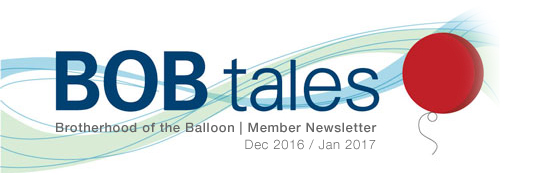

Dear Members (a note from Deb Hickey):
As the holiday season is upon us, the arrival of winter is defined by the typical string of preparations and events—shopping, cooking, decorating, planning and attending parties. It’s easy to forget to take a moment to reflect on the past year before we find ourselves staring at a calendar that says 2017. Our schedules become overbooked and obligations pile up. Now, more than ever, it’s important to embrace the true meaning of the holidays in the way we spend our days. It’s time to celebrate our valuable lives—our health, our family and friends, and all that we have to give and share.
In this issue of BOB Tales, we say thank you and farewell to a remarkable human being, who most of you know and adore—a man who’s had a tremendous impact on our organization; we also mourn the passing of a dear friend and perhaps our most distinguished member; we introduce another special member—a pastor, Bible teacher, author, and radio and television personality—whose words left me in tears when we spoke; we continue our critically important series on the book, Anticancer, and cover so much more. In fact, this is our longest and most comprehensive newsletter in history.
I also want to begin this month’s newsletter by expressing my heartfelt gratitude to all who have given back this year by making contributions to proton therapy research at Loma Linda University Cancer Center and those who have placed LLUCC in their estate plans as my father and I have done. Your generosity will impact the lives of thousands of men, women, and children. The Brotherhood of the Balloon is truly a brotherhood of a special group of people.
I also want to recognize and personally thank Dr. James Slater and Dr. Jerry Slater for creating the first hospital-based proton therapy center in the world at Loma Linda University nearly 30 years ago. Without Dr. Slater’s vision and determination to “Make Man Whole” by alleviating the pain, suffering and side effects of conventional cancer treatments, the devotion and persistence of his son, Dr. Jerry Slater, to carry this vision forward, and the support of LLUH leadership, our lives would look very different: I might not have my father; my daughter might not have her Papa; I wouldn’t be spending my days helping newly diagnosed men and their families and communicating with members of our incredible support group; the other proton centers might not exist. Many of us might not be enjoying the joy of life. For all these things, I am grateful.
As always, we welcome and encourage your feedback and suggestions to continuously improve the BOB Tales. Just send me an email.
Deb Hickey
To print the BOB Tales newsletter or view the newsletter with a larger font size, click here for the PDF file.
In This Issue:
- Anticancer Series Part III—Diet, Supplements & … Insects?
- Dr. J. Lynn Martell to Retire—Celebrate with us!
- PSA Bounce after Radiation—A Good Thing?
- Saturated Fat and Cholesterol Worsen Prostate Cancer
- In Memoriam: Ambassador Joseph Verner Reed (1937-2016)
- Meet Pastor James MacDonald
.jpg)
Anticancer Series Part III—Diet, Supplements … Insects?
In October, we began a series of articles on the book, Anticancer: A New Way of Life by David Servan-Schreiber, MD, PhD. This series is being authored by BOB member, Pat Greany, PhD, retired USDA research entomologist and courtesy professor at the University of Florida.
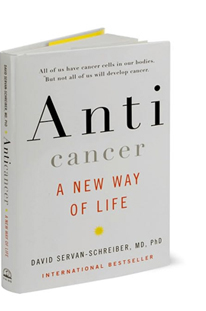 The book’s author, Dr. Servan-Schreiber (Dr. S-S) was a 31-year-old neuro-psychiatrist and scientist/researcher who accidentally discovered he had a deadly brain tumor. In his journey to stay alive, Dr. S-S set out to learn everything he could about the causes of cancer and how to combat cancer through diet and lifestyle changes. His findings are nothing less than shocking, and Anticancer has become the best-selling book about cancer in the world. Here is the third article in our series on this important book.
The book’s author, Dr. Servan-Schreiber (Dr. S-S) was a 31-year-old neuro-psychiatrist and scientist/researcher who accidentally discovered he had a deadly brain tumor. In his journey to stay alive, Dr. S-S set out to learn everything he could about the causes of cancer and how to combat cancer through diet and lifestyle changes. His findings are nothing less than shocking, and Anticancer has become the best-selling book about cancer in the world. Here is the third article in our series on this important book.
Part III: The Second Edition
The Second Edition of Anticancer was published in 2009. Dr. S-S brings forth many approaches to achieve an optimal anticancer lifestyle. Among them, he discusses a number of healthful foods that have been shown to have anticancer properties plus supplements that can be considered “nutraceuticals.” Some of the most noteworthy of these are discussed below. Along with this, we’ll briefly present the fascinating issue of the role of inflammation in prostate cancer and the influence of the anticancer foods and nutraceuticals as anti-inflammatory agents. A great deal of progress has been made since the publication of Anticancer and we have incorporated some of the newer findings, as space permits. We have provided hyperlinks to source materials that will enable you to read further.
By adopting an anticancer lifestyle and diet, in keeping with the principles identified by Dr. S-S, we should be able to significantly reduce the incidence of many cancers, including prostate cancer, which has spiked in the West during the past 76 years, as mentioned in the previous installment of this series. In many cases, prevention should be more effective and less expensive than intervention. Survival after conventional medical intervention should also be improved by subsequently following anticancer guidelines. In both cases, Dr. S-S speaks about fostering an improved “terrain,” strengthening the body to be better able to defend itself. How many times has your primary care doctor said “diet and exercise” are what you need to consider, but didn’t get specific? Dr. S-S helps provide the answers.
.jpg) Anticancer Foods
Anticancer Foods
Foods that Dr. S-S identifies as having anticancer properties are discussed in Chapter 8 of his book, with the discussion also weaving in stories about individual patients who were helped by following an anticancer regimen with these foods. Space doesn’t allow a complete synopsis of his discussion, but the foods that Dr. S-S recommends as being protective include some very familiar favorites: cabbage, broccoli, garlic, soy, green tea, raspberries, and dark chocolate, identified initially by Richard Béliveau, PhD, of the University of Montreal. Dr. Béliveau is a noted authority on anticancer foods and his website is a valuable resource. Others, such as tomatoes, have been added to the list.
Tomatoes: Tomatoes may be preventive. There’s an association with lycopene, a carotenoid in tomatoes, and a reduced risk of prostate cancer. Causality has not been proven, but it is certainly of interest. For folks who don’t have the possibility of conventional gardening, and yet want to grow their own tomatoes, you may want to consider straw bale gardening, which has gained great favor recently.
Some additional highlights:
Green tea components have been found to be effective against prostate cancer cells in vitro (in culture), especially when combined with soy.
Soy contains “powerful phytochemical molecules that counteract the mechanisms essential to the survival and spread of cancer.”
Olives and olive oil also contain antioxidants that slow progression of cancer.
Cruiciferous vegetables such as cabbages, Brussels sprouts, broccoli, and cauliflower possess agents that are powerful anticancer molecules, although some may be damaged by being boiled.
Garlic, onions, leeks, shallots and chives contain sulfur compounds that are protective.
Vegetables and fruits rich in carotenoids such as carrots and other bright-colored fruits and vegetables contain protective agents.
Various fruits such as berries, stone fruits (plums, peaches, and nectarines), plus citrus and pomegranates have anticancer properties.
Red wine may be protective, although alcohol can “significantly increase the risk of developing cancer…” (p. 126)
.jpg) Turmeric, used routinely as a spice in Asia, as in curry, is particularly interesting as an anticancer agent (pp. 114-115). It “is the most powerful natural anti-inflammatory identified today” (p. 113). It was described in a recent review by the famous ethnobotanist James Duke as the “Queen of COX-2-Inhibitors.” A recent review describes the turmeric major component, curcumin, as follows: “The chemopreventive and chemotherapeutic nature of curcumin as a therapeutic agent for the treatment of prostate cancer is promising.” Duke indicates it contains more than two dozen anti-inflammatory compounds, including 6 COX-2 inhibitors. He states, “In sum, safe and inexpensive turmeric is a viable contender with pharmaceutical drugs for preventing and/or treating Alzheimer’s disease, arthritis, cancer, scabies, and a range of other ailments—a true ‘gold standard’ of a Biblical spice!” Dr. S-S emphasizes that it must be mixed with pepper or ginger in order to be absorbed optimally (p. 116); commercial formulations of turmeric typically include black pepper extract. One might reasonably ask whether extensive use of turmeric in India may contribute to the extremely low rate of prostate cancer there, 23 times lower than in the U.S.
Turmeric, used routinely as a spice in Asia, as in curry, is particularly interesting as an anticancer agent (pp. 114-115). It “is the most powerful natural anti-inflammatory identified today” (p. 113). It was described in a recent review by the famous ethnobotanist James Duke as the “Queen of COX-2-Inhibitors.” A recent review describes the turmeric major component, curcumin, as follows: “The chemopreventive and chemotherapeutic nature of curcumin as a therapeutic agent for the treatment of prostate cancer is promising.” Duke indicates it contains more than two dozen anti-inflammatory compounds, including 6 COX-2 inhibitors. He states, “In sum, safe and inexpensive turmeric is a viable contender with pharmaceutical drugs for preventing and/or treating Alzheimer’s disease, arthritis, cancer, scabies, and a range of other ailments—a true ‘gold standard’ of a Biblical spice!” Dr. S-S emphasizes that it must be mixed with pepper or ginger in order to be absorbed optimally (p. 116); commercial formulations of turmeric typically include black pepper extract. One might reasonably ask whether extensive use of turmeric in India may contribute to the extremely low rate of prostate cancer there, 23 times lower than in the U.S.
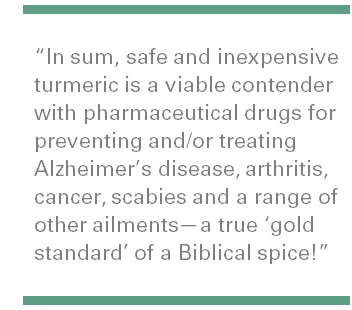 Synergy among anticancer foods as a “cocktail” is considered to be very important by Dr. Béliveau and Dr. S-S, protecting us by: “detoxifying carcinogenic substances; supporting our immune system; blocking the development of new vessels needed for tumor growth; preventing tumors from creating the inflammation that serves as their fertilizer; blocking the mechanisms that will enable them to invade neighboring tissues; and promoting the suicide of cancer cells.” (p. 125)
Synergy among anticancer foods as a “cocktail” is considered to be very important by Dr. Béliveau and Dr. S-S, protecting us by: “detoxifying carcinogenic substances; supporting our immune system; blocking the development of new vessels needed for tumor growth; preventing tumors from creating the inflammation that serves as their fertilizer; blocking the mechanisms that will enable them to invade neighboring tissues; and promoting the suicide of cancer cells.” (p. 125)
Nutraceuticals
These are agents that are typically derived from whole foods that can be used therapeutically, such as omega-3, containing triglycerides from fatty fish. The term is derived from “nutritional” and “pharmaceutical” and while it is being commonly used in marketing, it has no regulatory definition.
Vitamin D3 has “shown positive effects … on breast cancer, non-small-cell lung cancer, colon cancer, and prostate cancer.” (p. 141)
Omega-3 fatty acids, in particular, EPA and DHA, are recognized as being effective anti-inflammatory agents, even to a greater degree than recognized by Dr. S-S (p. 142). EPA and DHA and other omega-3s are typically produced by algae such as phytoplankton, ingested by small fish, which are eaten by larger fish, and so on, and are then obtained from the top predators, such as cod, and can be extracted as fish oil which is processed for human consumption. We cannot produce these omega-3s ourselves; we must obtain them from our diet and they are considered essential for our health. A review of the benefits of omega-3s and the mode of action conferring these benefits is advanced: They are considered to be a new class of “inflammation-regulating molecules.” Inflammation is recognized as a major driver of prostate cancer and other cancers, with the inflammation being caused by various sources, including: viruses; bacteria (e.g. Helicobacter pylori causes ulcers and can lead to gastric cancer); hormonal changes; and dietary habits (e.g., charred meats).
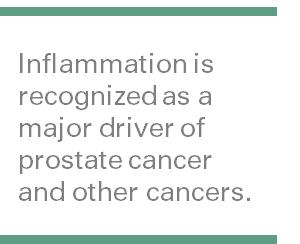 There is a great deal of concern about the sustainability of using deep-sea fish as our primary source of omega-3s. This has led to the use of other marine organisms, such as krill, plus other fish, such as Asian carp. Other possibilities include using cultured algae, which appeals to vegans, and use of flaxseed, which contains the omega-3 fatty acid, alpha-linolenic acid (ALA), which can be converted to EPA and DHA, but this is a slow and very inefficient process according to the highly-regarded medical oncologist and advanced prostate cancer specialist, Dr. Charles “Snuffy” Myers, in his book Flaxseed: Panacea or Poison?
There is a great deal of concern about the sustainability of using deep-sea fish as our primary source of omega-3s. This has led to the use of other marine organisms, such as krill, plus other fish, such as Asian carp. Other possibilities include using cultured algae, which appeals to vegans, and use of flaxseed, which contains the omega-3 fatty acid, alpha-linolenic acid (ALA), which can be converted to EPA and DHA, but this is a slow and very inefficient process according to the highly-regarded medical oncologist and advanced prostate cancer specialist, Dr. Charles “Snuffy” Myers, in his book Flaxseed: Panacea or Poison?
 He also cautions readers that a Harvard School of Public Health study involving more than 40,000 men followed over 10 years showed that “… a diet rich in the major plant omega-3 fatty acid, ALA, significantly increased a person’s risk of developing advanced prostate cancer (emphasis added). In contrast, omega 3 fats from fish reduced the risk of advanced prostate cancer.” He also states “It is certainly clear that flaxseed oil is not an adequate source of omega 3 fatty acids for men,” and, “as far as prostate cancer is concerned, there appears to be no valid case to be made for the use of flaxseed oil.” However, he does allow for the possibility that ground flaxseed may have some utility because of the presence of other compounds.
He also cautions readers that a Harvard School of Public Health study involving more than 40,000 men followed over 10 years showed that “… a diet rich in the major plant omega-3 fatty acid, ALA, significantly increased a person’s risk of developing advanced prostate cancer (emphasis added). In contrast, omega 3 fats from fish reduced the risk of advanced prostate cancer.” He also states “It is certainly clear that flaxseed oil is not an adequate source of omega 3 fatty acids for men,” and, “as far as prostate cancer is concerned, there appears to be no valid case to be made for the use of flaxseed oil.” However, he does allow for the possibility that ground flaxseed may have some utility because of the presence of other compounds.
The world market for sale of omega-3 fatty acid supplements is approximately $3.2 billion, and the demand is growing, even in Asia, where they still consume a lot of fish! Recognizing that there is great market potential for these agents, at least two GMO plants have been created, an oilseed that produces EPA and DHA, and a soybean, by Monsanto. Because these are genetically-engineered GMOs, some consumers will resist consuming them or their derivatives.
Eat Insects? The Rest of the World Does.
Another source of EPA and DHA that has great potential and is sustainable is the use of factory-reared insects (particularly interesting to me, as an insect physiologist). At this moment, there are factories in British Columbia and in the Netherlands producing huge quantities of insects that are processed as food and feed for livestock, and as oil that could be used for human consumption. Research at Wageningen University showed that this oil contains significant quantities of essential omega-3s, including EPA and DHA.
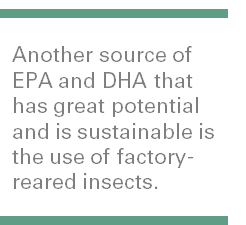 Okay, you may not want to follow the example of billions of people in the world who already are routinely including insects in their diet. We westerners have been conditioned to reject them as food (the “yuck factor”). But, how about at least considering using the healthful omega-3 oil derived from them? As pointed out by my friend Dr. Marcel Dicke in his fascinating TED talk, “Why not eat insects?” The world’s population is growing rapidly and we will ultimately and necessarily join the 80 percent of the world’s population that already eats insects. The world’s population is expected to reach at least 9.7 billion by 2050. We really are going to need to adapt! As pointed out by Dr. S-S, our diet has been dramatically affected by food-processing companies since 1940, with a preponderance of omega-6 fatty acids derived especially from corn and soybean oil. As he emphasizes, and as elucidated here, this imbalance in the omega-6 to omega-3 fatty acids is making us sick! Perhaps insects can help us solve this problem.
Okay, you may not want to follow the example of billions of people in the world who already are routinely including insects in their diet. We westerners have been conditioned to reject them as food (the “yuck factor”). But, how about at least considering using the healthful omega-3 oil derived from them? As pointed out by my friend Dr. Marcel Dicke in his fascinating TED talk, “Why not eat insects?” The world’s population is growing rapidly and we will ultimately and necessarily join the 80 percent of the world’s population that already eats insects. The world’s population is expected to reach at least 9.7 billion by 2050. We really are going to need to adapt! As pointed out by Dr. S-S, our diet has been dramatically affected by food-processing companies since 1940, with a preponderance of omega-6 fatty acids derived especially from corn and soybean oil. As he emphasizes, and as elucidated here, this imbalance in the omega-6 to omega-3 fatty acids is making us sick! Perhaps insects can help us solve this problem.
MD Anderson Cancer Center Anticancer Research Program
We’ve all heard the term “alternative medicine.” There’s a new term for this approach, “Integrative Medicine,” with a focus on integrating a wide array of therapeutic approaches including yoga, acupuncture, and stress reduction, along with conventional therapies.
This is much more comprehensive than the classical model, focused primarily on destroying the tumor. This approach was adopted at the University of Texas MD Anderson (MDA) Cancer Center in 1998. Memorial Sloan Kettering also created an Integrative Medicine program in 1999. The MDA program is headed by Alonzo Cohen, PhD.
Bob Marckini and I had the privilege of interviewing Dr. Cohen this past August. During this interview, we learned that their studies were fostered by early interactions with Dr. Servan-Schreiber and Dr. Cohen, facilitated by the president of MDA at the time. Dr. S-S knew that anecdotal evidence supporting approaches such as the use of turmeric was insufficient to gain favor among physicians basing their treatments on evidence gained through properly controlled trials.
The result of this connection is the MDA Anticancer Research Program, which is intended to “dramatically move the integrative medicine field forward through several ground-breaking strategies where previous research has fallen short.” The specific goals of the program include a “comprehensive, novel, standardized, web-based, integrative oncology intervention program based on the model outlined in Anticancer.” Their studies are “examining lifestyle changes in the areas of diet/nutrition, physical activity, and stress management/social network to change the risk of developing cancer and influencing outcomes in those with cancer.” Click here to assist the Servan-Schreiber/Cohen Anticancer Fund in these efforts.
Conclusions
The main dietary take-away points I gleaned from reading Anticancer and the subsequent studies were the following:
- Avoid sugar, omega-6 rich vegetable oils and flaxseed oil and of course, carcinogenic environmental agents.
- Some foods can be preventive, with significant anticancer properties, including broccoli and other cruciferous vegetables.
- Turmeric (with black pepper included) and the essential omega-3s EPA & DHA are important and readily available anti-inflammatory agents. We should consider including these as components of our daily regimen to inhibit inflammation, which can be a powerful promoter of many cancers, including prostate cancer.
In our next (final) installment in this series, we will discuss some of the more psychologically and socially oriented aspects of the anticancer approach, such as stress reduction.
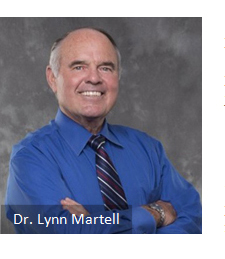 Dr. J. Lynn Martell to Retire
Dr. J. Lynn Martell to Retire
Written by Bob Marckini
Anyone who has read my book or our newsletters knows of Dr. J. Lynn Martell. What you may not know is the profound impact he has had on our organization and on my life.
I first met Lynn in October 2000 while I was in treatment. He and Gerry Troy used to team up and run the Wednesday night meetings at LLUCC. For me, this was the highlight of the week. Gerry and Lynn knew the patients who were coming to LLUCC for treatment were scared about their diagnosis and uncertain about their future. They used the Wednesday night meetings to lighten things up; to teach us about proton technology; and to stress the importance of a healthful lifestyle.
None of us realized until sometime later, that the Wednesday night meetings, along with the many other patient social activities, were all part of the LLUCC mission to “Make Man Whole.”
Many patients have said, “I liked Lynn Martell the minute I met him.” He’s that kind of a guy. I didn’t know at the time that he was a pretty high-ranking pastor in the Seventh-day Adventist Church, or that someday we would be having in-depth discussions about the Bible and spirituality.
Lynn became aware of our newly formed group of six patients in treatment who wanted to keep in touch with each other; to compare notes on such things as PSA progression and side effects after treatment. We jokingly referred to ourselves as the Brotherhood of the Balloon, for reasons we all know.
Before we completed treatment and left for home, Lynn encouraged others to join our group. He believed we were onto something important. When I completed my proton treatment in December 2000, we had 19 members in our group from 14 states.
Lynn later shared with me that he saw our group as something far more than a few guys who wanted to keep in touch. He saw us as an extension of the LLUH mission (To Make Man Whole). He believed that our group had the potential to maintain the positive, upbeat atmosphere patients experienced while in treatment, a spirit that would not only keep us connected, but would serve to support our healing and wholeness.
He encouraged me to grow the group and expand our mission. And later, when I was considering abandoning this “ministry” because of the huge workload and time commitment, Lynn persuaded me to stay the course and provided resources to help us grow into the organization we have become today.
We are approaching 9,000 members in 50 US states and 39 countries. Our mission to stay connected, promote proton therapy, and give something back is alive and well.
Lynn Martell has been far more than our cheerleader for the past 16 years. He has been a mentor, a problem solver, a friend, and even a spiritual adviser. I began studying the Bible a few years ago, and each time I struggled with a passage, I’d call Lynn to discuss it. And every time we talked, I had a better understanding of the Scriptures.
Whenever we had family health issues, Lynn and his wife, Karen, would call to have prayer with us. Their prayers always helped. I know that Lynn has done the same for so many of our members when they suffered setbacks or the loss of loved ones.
Dr. Martell has earned the right to retire and spend time with his lovely wife, touring the country in their fifth wheel towed behind their RAV-4 and spending time with their three children and seven grandchildren. And I know Lynn well enough to know he’ll keep a list of BOB members with him as he tours the country, finding ways to connect with members of our group through mini BOB reunions.
We all love you Lynn. We wish you good health and happiness in your well-deserved retirement.
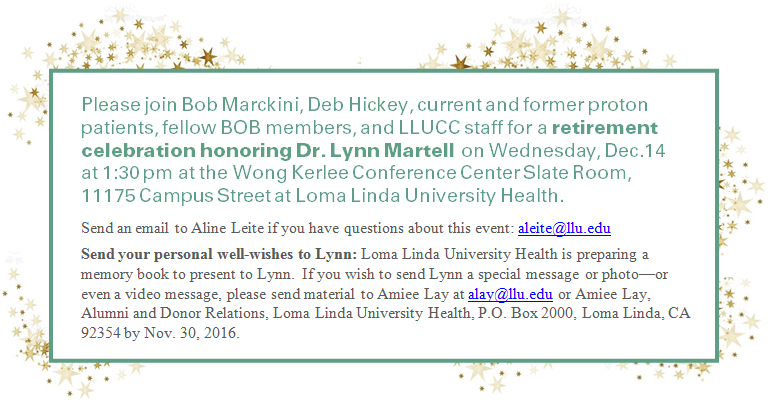
PSA Bounce after Radiation—A Good Thing?
We have been told by our oncologists that we can expect our PSAs to drop after treatment, but not necessarily in a linear fashion, and we should not try to predict the next reading. Bob Marckini was thrilled with his first PSA result after treatment 16 years ago; it dropped from a pre-treatment level of 8.0 to 3.6 in just four months. Six months later, he was disappointed because it fell to only 3.3. Could this be my nadir? He thought. No, as it turned out.
We have learned much about post-treatment PSA progression in the past 16 years. One thing we’ve learned is that PSA readings after proton therapy can be a bit of a rollercoaster ride, especially during the first three years.
A recent study, reported in the International Journal of Clinical Oncology, concluded that certain PSA bounces after radiotherapy may be a predictor of a good outcome.
Researchers followed 691 prostate cancer patients, ages 49 to 87, who were treated with external beam radiation therapy or brachytherapy. Patients ranged from low- to very high-risk and were followed with PSA tests every three to six months for the first five years, and then annually.
In total, 33 percent of the patients experienced a PSA bounce. Those who experienced a PSA bounce in the 15–18 month range were associated with improved biochemical disease-free survival. Those with PSA bounces in the 28–53 month range were more likely to have a biochemical failure. Biochemical failure was defined as a 2.0 ng/mL or higher rise in PSA above nadir value.
Researchers concluded that experiencing a PSA bounce was associated with improved biochemical disease-free survival, especially if it occurred sooner after radiotherapy than later. Patients 70 years and older were more likely to have a PSA bounce. And patients with Gleason 6 prostate cancer were the most likely to have a PSA bounce.
Saturated Fat and Cholesterol Intake Worsens Prostate Cancer
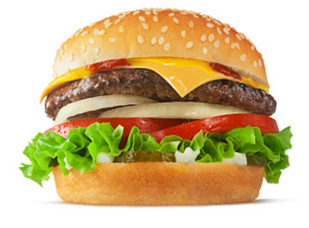 According to a new study published in Prostate Cancer and Prostatic Diseases, eating saturated fats (fatty beef, lamb, pork, cream, butter, baked goods, cheese, etc.) and foods high in cholesterol (egg yolk, liver, fast food, processed foods, red meat, cheese, baked goods, ice cream, butter, etc.) may make prostate cancer more aggressive.
According to a new study published in Prostate Cancer and Prostatic Diseases, eating saturated fats (fatty beef, lamb, pork, cream, butter, baked goods, cheese, etc.) and foods high in cholesterol (egg yolk, liver, fast food, processed foods, red meat, cheese, baked goods, ice cream, butter, etc.) may make prostate cancer more aggressive.
Researchers followed 1,854 prostate cancer patients from the North Carolina-Louisiana PC Project and monitored dietary intake and prostate cancer severity. The consumption of higher saturated fats was associated with a higher risk for aggressive prostate cancer compared with those who consumed less. Similarly, the consumption of higher amounts of dietary cholesterol was associated with prostate cancer aggressiveness among European-Americans, compared with those who consumed less. The latter association was not seen among African-Americans.

In Memoriam: Ambassador Joseph Verner Reed (1937-2016)
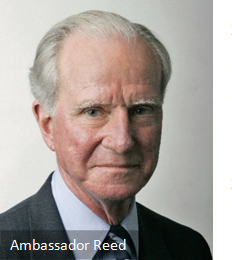 We lost a good friend and a staunch supporter of proton therapy last month. Ambassador Joseph Verner Reed was, perhaps, the most distinguished, influential and renowned member of our group.
We lost a good friend and a staunch supporter of proton therapy last month. Ambassador Joseph Verner Reed was, perhaps, the most distinguished, influential and renowned member of our group.
There is not enough space here to cover the ambassador’s many achievements. To highlight a few, he was undersecretary-general of the United Nations, former US ambassador and chief of protocol for President George H.W. Bush. He served in the UN for 25 years as adviser to four secretaries general and traveled the globe as a UN envoy and adviser to each.
A Yale graduate, Reed became the private secretary to the head of the World Bank, vice president of the Chase Manhattan Bank and assistant to the chairman, David Rockefeller, who recently said of Reed, “He was a man of elegance, grace, wit, flamboyance and razor sharp intellect, a diplomat’s diplomat.”
Joseph—as he asked us to call him—was appointed ambassador to Morocco by President Ronald Reagan and was a friend to Queen Elizabeth II and many other notables.
Interestingly, one thing of which he was most proud was his membership in the Brotherhood of the Balloon. He was an avid reader of the BOB Tales, “I read it cover to cover every month,” he told us when we interviewed him for a newsletter story six months ago.
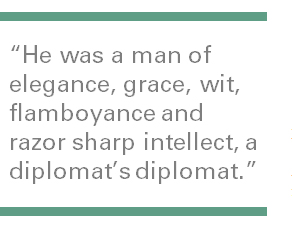 Like clockwork, Joseph would email Deb Hickey a few days after each BOB Tales was published, commenting on an article or thanking us for what we do. He loved our brain teasers and would occasionally send us one for the newsletter. The one we are using in this issue was sent to us by Joseph for our September 2005 issue.
Like clockwork, Joseph would email Deb Hickey a few days after each BOB Tales was published, commenting on an article or thanking us for what we do. He loved our brain teasers and would occasionally send us one for the newsletter. The one we are using in this issue was sent to us by Joseph for our September 2005 issue.
Ambassador Reed was a big fan of Loma Linda University Cancer Center where he and his wife of 56 years, Mimi, were treated several years ago. 
Earlier this year, Dr. Richard Hart, president of LLUH, visited Ambassador Reed at his home in Greenwich, CT and presented him with the organization’s highest honor, the Distinguished Service Award. Ambassador Reed was also a member of the LLUH Heritage Society and has contributed generously to LLUH programs in the past.
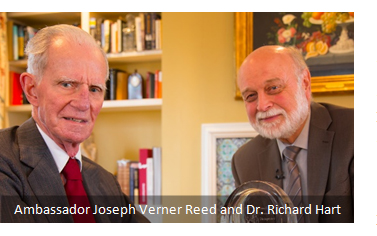 In January 2004, Ambassador Reed hosted a visit to the United Nations by Bob Marckini, Lynn Martell, and Elder Neal Wilson, former leader of the Seventh-day Adventist General Conference. We had a personal guided tour of the UN, including the General Assembly, Security Council and Economic and Social Council. We met ambassadors from other countries, as well as other distinguished people from around the world.
In January 2004, Ambassador Reed hosted a visit to the United Nations by Bob Marckini, Lynn Martell, and Elder Neal Wilson, former leader of the Seventh-day Adventist General Conference. We had a personal guided tour of the UN, including the General Assembly, Security Council and Economic and Social Council. We met ambassadors from other countries, as well as other distinguished people from around the world.
In writing about this event in the February 2004 BOB Tales, Bob Marckini wrote:
Three and a half years ago when I was diagnosed with prostate cancer, I thought my world had ended and that my life was over. Little did I realize at the time, that the diagnosis would turn out to be one of the most positive events of my life. Through it, I discovered the healing power of Loma Linda and proton therapy; made numerous, new lifelong, friends; participated in founding and running an international support group that is making significant impact on people’s lives; met new and interesting people from all over the world; and found myself walking the hallowed halls of the United Nations with three people whom I greatly respect and admire. If anyone had told me, three and a half years ago, that these things would happen, I would have laughed at them.
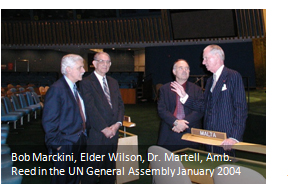 Ambassador Reed loved Bob’s book and provided an endorsement quotation for the back cover, which read, “A landmark of a book.” He always had several copies on hand to give to friends and acquaintances. Whenever someone he knew had rising PSA, Joseph encouraged them to read Bob’s book and to call us. We heard from many of these people through Joseph’s prompting, from his beekeeper to a U.S. senator.
Ambassador Reed loved Bob’s book and provided an endorsement quotation for the back cover, which read, “A landmark of a book.” He always had several copies on hand to give to friends and acquaintances. Whenever someone he knew had rising PSA, Joseph encouraged them to read Bob’s book and to call us. We heard from many of these people through Joseph’s prompting, from his beekeeper to a U.S. senator.
We will miss Joseph’s monthly notes, his words of encouragement, his brain teasers, but mostly we will miss our friend.
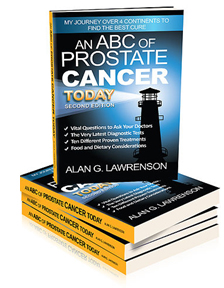 BOB Member Pens Second Book on Prostate Cancer
BOB Member Pens Second Book on Prostate Cancer
BOB member Alan Lawrenson has written his second book, An ABC of Prostate Cancer Today: My Journey Over 4 Continents to find the Best Cure. The book is the second edition to his first book, which was published last year. In it, Lawrenson discusses his prostate cancer diagnosis in 2012 and the extensive research he did to find his way to proton therapy. The book provides readers with the latest information on diagnostic testing and treatment options. He encourages men to take a proactive role in the treatment research process and delves deeply into diet, nutrition, and alternative treatments.
Lawrenson, from Sydney, Australia, is a strong proponent of proton therapy and an active speaker at prostate cancer support groups. Learn more about Alan and his book.
Meet Pastor James MacDonald
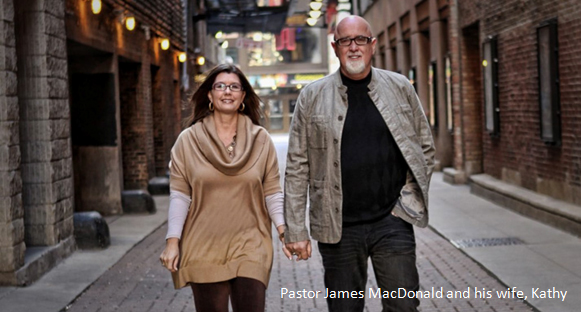
James MacDonald (D. Min. Phoenix Seminary) is married to his high school sweetheart, Kathy. Both are from Ontario, Canada. They are the parents of three grown children and grandparents to five boys. James has committed his life and ministry to God’s Word. In 1988, with 18 people, James and Kathy founded Harvest Bible Chapel, which ministers to more than 13,000 people at seven campuses across Chicago. At just 27, James was invited to serve as the senior pastor.
In addition to preaching, James began Walk in the Word, a Bible-teaching ministry, on a radio station in 1997. Today the radio broadcast reaches more than three million people daily, and the Walk in the Word television program, launched in 2014, has a daily audience that extends around the world.
James is also the author of Lord, Change My Attitude, Act Like Men, and Vertical Church. He has over 300,000 followers on Twitter and nearly 300,000 fans on Facebook. James’ extensive ministry also includes a training center for pastors, a year-round camp, a center for biblical counseling, a disaster-recovery organization, and an accredited Christian school.
An Uplifting Conversation
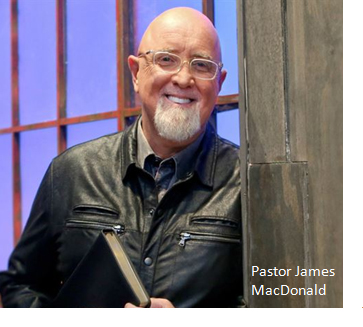 Bob Marckini and Deb Hickey had Pastor James MacDonald’s name on a “wish list” of BOB members to interview and feature in the BOB Tales newsletter, but due to bandwidth and other issues, it took nearly a year to nail down the time for a phone conversation. On Thursday, Oct. 20 Deb finally spoke with James. She never expected how she would feel an hour later.
Bob Marckini and Deb Hickey had Pastor James MacDonald’s name on a “wish list” of BOB members to interview and feature in the BOB Tales newsletter, but due to bandwidth and other issues, it took nearly a year to nail down the time for a phone conversation. On Thursday, Oct. 20 Deb finally spoke with James. She never expected how she would feel an hour later.
Deb was nervous. This guy has been speaking in front of millions of people across the world for decades. After doing her research and watching several of his TV programs, Deb concluded that James MacDonald is one of the most confident and inspiring public figures, perhaps in the world. And here I am, curious to learn about his prostate cancer experience. I wonder if he’ll be put off by my questions or uninterested in sharing this part of his life, she thought.
How wrong she was.
Within the first two minutes of their conversation, James spoke about the impact Bob had on his life during a tumultuous and what he referred to as “super scary” time in his life. “Bob was my guide,” said James. “He was very dear to me before I had the privilege of meeting him or calling him my friend.”
Without having to ask any questions, James shared with Deb his prostate cancer diagnosis, his journey to proton treatment and Loma Linda University Cancer Center, and his overwhelming gratitude for the entire experience.
James MacDonald’s Prostate Cancer Journey: In His Own Words
 I was diagnosed with prostate cancer in Oct. 2008, at the age of 48. My doctor, unbeknownst to me, had been tracking my PSA for years during my annual physical. He never mentioned it to me until it reached 3.2. But, it wasn’t so much the score—it was the steady increase. He sent me for more testing. Cancer was found in four cores in one of the regions of my prostate and my Gleason score turned out to be 3+4=7. I was scared. I had no idea what this meant or how long I had to live, but I remember thinking I had just weeks. Like most people since the new millennium, I jumped on the Internet and scared the life out of myself.
I was diagnosed with prostate cancer in Oct. 2008, at the age of 48. My doctor, unbeknownst to me, had been tracking my PSA for years during my annual physical. He never mentioned it to me until it reached 3.2. But, it wasn’t so much the score—it was the steady increase. He sent me for more testing. Cancer was found in four cores in one of the regions of my prostate and my Gleason score turned out to be 3+4=7. I was scared. I had no idea what this meant or how long I had to live, but I remember thinking I had just weeks. Like most people since the new millennium, I jumped on the Internet and scared the life out of myself.
After some research, I boiled my choices down to surgery (Get it out!) or radiation in some capacity … or freezing perhaps. But, one of my biggest concerns was side effects. It seemed to me that all the cure rates were similar among treatments, but the side effects from some of these treatments were frightening. Incontinence! Impotence! That’s what changed the game for me.
Somehow in my research I came upon this book, You Can Beat Prostate Cancer: And You Don’t Need Surgery To Do It. Let me tell you, I spent my life studying God’s Word and after the Bible, I don’t remember devouring a book like that—I bookmarked; I underlined; I made notes in the margin. Bob had taken a very complicated subject and turned it into a light in my life that ultimately led to my treatment decision.
I was probably one of the thousands of guys who called Bob during the years he spent 24 hours every day talking with newly diagnosed men. He took a lot of time talking to me about the treatment and about Loma Linda University Cancer Center.
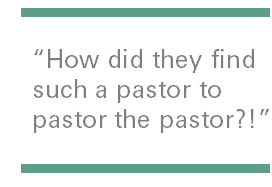 Shortly thereafter, I spoke with the people at LLUCC. I don’t know what to say about Lynn Martell. That guy actually prayed with me on the phone! That had a profound impact on me. How did they find such a pastor to pastor the pastor?!
Shortly thereafter, I spoke with the people at LLUCC. I don’t know what to say about Lynn Martell. That guy actually prayed with me on the phone! That had a profound impact on me. How did they find such a pastor to pastor the pastor?!
I was at LLUCC very quickly. Why did I go all the way to California? I wanted the original—the place where everything began. Let’s put it this way: There are a lot of McDonald’s in the world, but the original is in Des Plaines, IL, which happens to be a short drive from my home. And when I want a burger, that’s where I go. Between Bob Marckini, Lynn Martell, and the original place … Well, I’m not the sharpest knife in the drawer, but I could do the math on that.
Treatment
James and Kathy were warmly received as James began his treatment. It was difficult to be away from his church, but a pastor friend in nearby Riverside, CA, invited James to preach at his church. He did a six-week series during his treatment on the topic, What does the Bible say about trials? “The main verse from the series was Job 23:10, ‘But He knows the way that I take; when He has tried me, I will come forth as gold’ … I took that as my personal verse during my treatment,” James said. “I trusted God and in the end, we had the most awesome experience.”
The two returned home in March. “I was, and still am, extremely grateful,” James said. “I’ve had no real side effects; I am 56; and my PSA is low. Other than a recent knee replacement, my health is great.”
A Special Thank You
Deb was moved by James’ openness. He shared more than she ever expected. And the words he used to describe her father made her proud. Toward the end of the conversation, Deb felt compelled to thank James for the prayers he said for her husband, Mark, when he was diagnosed with pancreatic cancer back in March 2014. “My father asked you to pray for us. You did more than that; you asked your 300,000 Twitter followers to pray for us; you spoke to your congregation and asked them to pray for us,” Deb said, her voice breaking. “Just knowing that you—a man of such great faith, and with such a busy schedule—took the time to do that means everything to me. And I think we received a miracle.”
James left Deb with this:
“God is especially inclined to grant your request where He sees in the heart of the people intent to give Him the praise or the glory from that. You’re like that … and your dad’s like that …” And then he referenced this hymn: “God gave me this song today and I will sing the mercies of the Lord forever.”
Thank You, Reference List Volunteers
Below is a message we received from a prospective proton therapy patient. He had a hip replacement and was concerned it may affect his treatment. We sent him our hip replacement patient reference list—a list of men, all who had hip replacements prior to proton treatment, who are willing to share their experiences and results with others.
The following feedback reminds us how important our reference lists are. Thank you to all who volunteer to email and/or speak with newly diagnosed men. You are making a difference.
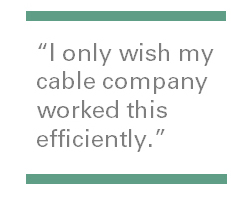 Thank you very much for the two lists of contact names you sent me—I especially found the hip replacement list very helpful. I was truly amazed and overwhelmed at the speed in which everyone I called ALL returned my call. One of the men literally called me within minutes of sending him an email. I only wish my cable company worked this efficiently.
Thank you very much for the two lists of contact names you sent me—I especially found the hip replacement list very helpful. I was truly amazed and overwhelmed at the speed in which everyone I called ALL returned my call. One of the men literally called me within minutes of sending him an email. I only wish my cable company worked this efficiently.
If you are at least six months out of treatment and willing to share your experience and outcome with newly diagnosed men, please send an email to [email protected].

ASTRO 2016
The American Society for Therapeutic Radiation Oncology held its annual meeting in Boston in October with more than 11,000 in attendance. The president of DOTmed, Philip Jacobus, had the following to say about the event:
After attending ASTRO, it occurred to me how lucky we are to be living today. Researchers and physicians are all working toward eradicating cancer and this is more evident at ASTRO than any other show I attend throughout the year.
Let me give you an example: Varian Medical Systems put together a panel discussion by Dr. Ricky Sharma from the University College in London. On the panel was Varian’s Renate Parry and four physicians; Dr. John Perentesis from Cincinnati Children’s Hospital, Dr. Quynh-Thu Le from Stanford University, Dr. Andrew Sharabi from UC San Diego, Dr. James Metz from the University of Pennsylvania.
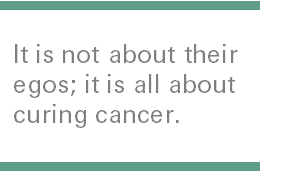 I am not a physician but you did not have to be one in order to follow the conversation. This particular discussion dealt with proton therapy and at times compared it to electrons and photons. The four physicians were sharing with their colleagues in the audience dose-painting techniques, the relative biological effectiveness of different treatment regimens or which treatment techniques were best and when.
I am not a physician but you did not have to be one in order to follow the conversation. This particular discussion dealt with proton therapy and at times compared it to electrons and photons. The four physicians were sharing with their colleagues in the audience dose-painting techniques, the relative biological effectiveness of different treatment regimens or which treatment techniques were best and when.
Dose-painting techniques are ways to use proton therapy to “paint” the tumor and involve the use of drugs in conjunction with proton therapy. I could not help but be impressed with how many variables our healthcare providers take into account when choosing the right treatment.
In fact, I visited with several physicians at ASTRO and I was very encouraged at how committed these dedicated experts seem to be. It is not about their egos; it is all about curing cancer.
I hope it happens in my lifetime and if it does, it is because of the type of physicians who attend ASTRO.

Why LLUCC?
It was when Dr. James Slater was in his residency program at medical school that he first noticed the discomfort experienced by his patients because of the imprecise targeting of the X-ray radiation beam. He believed in his heart that radiation could be delivered more precisely. A fellowship took him to MD Anderson. There, he became interested in heavy-charged particle therapy.
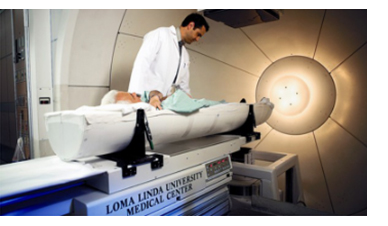 Later, Dr. Slater set up a team to help him achieve an almost impossible goal: To bring proton therapy to a hospital setting. This culminated with the opening of the first hospital-based proton treatment center in the world at Loma Linda University Cancer Center in 1990. Since that time more than 150,000 patients have been treated with protons; most of these have been cured of their cancers and other diseases; and most have enjoyed excellent quality of life as a result of their proton treatment. Dr. Jerry Slater has picked up the mantle and for the past several years has led the Department of Radiation Medicine, as well as basic and clinical research programs.
Later, Dr. Slater set up a team to help him achieve an almost impossible goal: To bring proton therapy to a hospital setting. This culminated with the opening of the first hospital-based proton treatment center in the world at Loma Linda University Cancer Center in 1990. Since that time more than 150,000 patients have been treated with protons; most of these have been cured of their cancers and other diseases; and most have enjoyed excellent quality of life as a result of their proton treatment. Dr. Jerry Slater has picked up the mantle and for the past several years has led the Department of Radiation Medicine, as well as basic and clinical research programs.
When Bob Marckini was treated for prostate cancer in 2000, LLUCC was the only proton center treating in the U.S. Today, as a result of the Slaters’ pioneering work, there are 25 proton centers in the U.S. and several more in the planning and construction stages.
Please help us thank Dr. James Slater and Dr. Jerry Slater for their pioneering efforts and all they do to continually develop and improve proton therapy.
We charge no dues for membership in our group. Our members repeatedly tell us we provide considerable value to them through the various programs we have established over the years, beginning with Bob Marckini’s book and including our website, patient testimonials, 35 patient reference lists, medical insurance support and documentation, PowerPoint presentations, response to questions/emails/phone calls and especially our comprehensive monthly newsletters with timely information about new developments in prostate cancer prevention, detection, treatment, as well as the latest developments in proton therapy for treating prostate cancer and other diseases.
We don’t benefit from your gifts firsthand, but we are passionate about improving the use of proton therapy to benefit more people because we are dedicated to the advancement of this incredible technology and LLUCC is the institution that started it all. Without Dr. James M. Slater and his dream some 45 years ago, no other proton centers would likely exist. We are the beneficiaries of that dream.
Your contributions help researchers who are studying new applications for the proton beam as well as physicians and scientists who are conducting clinical studies to determine better ways to use proton therapy to benefit more patients. Your gifts allow doctors to use proton technology to treat new cancer sites, new medical conditions, eliminate seizures in children, and help our war veterans.
.jpg) There are numerous stories in the media about people who have had to leave their country to access proton therapy, or set up funding programs to pay for proton treatment. So many struggle to gain access to proton therapy and at the same time more and more insurance providers are cutting proton therapy from their coverage plans for cost reasons. Yet there is undeniable proof of the advantages of this precision form of treatment. Research programs and clinical trials need funding to bring the programs to completion, to lower the cost of treatment and to prove, once and for all, that proton therapy is superior to other forms of radiotherapy.
There are numerous stories in the media about people who have had to leave their country to access proton therapy, or set up funding programs to pay for proton treatment. So many struggle to gain access to proton therapy and at the same time more and more insurance providers are cutting proton therapy from their coverage plans for cost reasons. Yet there is undeniable proof of the advantages of this precision form of treatment. Research programs and clinical trials need funding to bring the programs to completion, to lower the cost of treatment and to prove, once and for all, that proton therapy is superior to other forms of radiotherapy.
Please help others have access to the treatment we’ve had the privilege of receiving. We urge you to consider: 1) Making a year-end gift to the Loma Linda University Cancer Center for proton research, and/or 2) Putting Loma Linda University Health in your estate plan. We have done this and many of our members tell us they have as well.
We are grateful for your generosity.
How to Contribute to Proton Research
- Donate Online: Visit the LLUCC website. Make sure the “Designation Type” is set to “Proton” and the “Designation” is set to “Robert J. Marckini Chair.
- Send a Check: Make your check out to “LLUCC Proton” with “Marckini Chair” in on the memo line and send to: LLUH, Office of Philanthropy, P.O. Box 2000, Loma Linda, CA 92354.
- Make a Call: Contribute by phone. Contact Elvia DeHaro at 909-558-5010
- Make a Future Gift: Contact Todd Mekelburg at the Office of Planned Giving at Loma Linda University Health at 909-558-5376 or email [email protected].
- Other Ways to Give: Contact Matt Miller at the Office of Philanthropy at Loma Linda University Health at 909-558-3582 or email [email protected].

Series: “Make Vegetables Taste Good”
This is the fifth segment on a subject that’s consistent with our Anticancer series and the first submission by a newsletter reader—BOB member spouse, Priscilla Goodger. Thank you, Priscilla!
Deb Hickey made it her mission to find recipes that make the most healthful vegetables something to look forward to at dinnertime. She learned a lot about specific vegetables and how some fight specific health issues while others interact with each other to become “super” foods that target specific cancers. After much research and experimentation, we are happy to share what we’ve learned. And, we are happy to accept and try recipe submissions by our readers. Have a vegetable-based recipe that you find irresistible? Send it to us!
Priscilla’s Bean Soup with Kale
Cooking time: 45-60 minutes (prep and cooking)
Ingredients:
- 1 medium yellow onion, chopped
- 8 large garlic cloves, crushed
- 1 tbsp olive oil
- 4 cups chopped, raw kale
- Four cups low-fat, low-sodium chicken or vegetable broth—divided
- Two 15 oz. cans white beans (cannellini), undrained—divided
- 4 plum tomatoes, chopped
- 2 tsp dried Italian herb seasoning
- Salt and pepper
- ½ cup chopped parsley
Directions:
- Sauté onion and garlic in oil until soft
- Add kale and sauté until wilted
- Add 3 cups broth
- Add 2 cups beans and liquid
- Add tomatoes
- Add Italian herb seasoning
- Salt and pepper to taste
- Simmer 5 minutes.
- In a food processor, process the remaining beans and broth until smooth
- Stir into soup to thicken.
- Simmer 15 minutes.
- Adjust seasonings
- Sprinkle with parsley and serve!
Dangerous Bacteria Found on Cucumbers
According to the University of California, Berkeley Wellness Letter, a major outbreak of food poisoning in 29 states was linked to cucumbers contaminated with salmonella. Produce such as cucumbers, melons, and avocados should be scrubbed with a clean vegetable brush before peeling and/or slicing. This will prevent the knife from spreading bacteria to the interior of the produce. Soap or special cleansers are not necessary and not recommended. It is also recommended that you refrigerate firm produce to prevent the growth of bacteria.

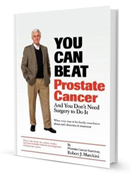
A Quick and Easy Way to Pay it Forward
Did Bob’s book help you? If so, please help others navigate the maze of prostate cancer treatment options. Help them find their way to proton therapy posting a review of Bob Marckini’s book. The more positive reader reviews, the more likely Amazon’s search engine will list the book at the top of the search results when users search for “prostate cancer treatment” and “proton therapy.” Also, with more positive reader reviews, the more likely Amazon will “recommend” the book to readers of other prostate cancer-related books and products. Please help us reach 300 reviews by the end of the year—that’s just 21 more!

“You’re a poster boy” is an inside joke that you will understand once you’ve read this book. Mr. Marckini makes note of three doctors, each of which had their own specialty in treating prostate cancer, who told him that he is a “poster boy” for their specific treatment … There are doctors out there who are more interested in their wallet than your prostate.
Was Bob’s book helpful to you? If you haven't already, please post a review on Amazon today.
Buy Online, in Bulk or in Spanish
Online: Paperback: $19.00--•--Kindle: $9.99--•--NOOK Book: $9.99--•--Apple iBook: $9.99
In Bulk: Conctact us for a discount price list. Proceeds from book sales support proton therapy research through the Robert J. Marckini Endowed Chair at LLUCC.
In Spanish: Buy the print version or in eBook format.

Why?
- Why is “abbreviated” such a long word?
- Why is it that doctors and attorneys call what they do “practice?”
- Why is the person who invests all your money called a broker?
- Why is the time of day with the slowest traffic called rush hour?
- Why didn’t Noah swat those two mosquitoes?
- You know that indestructible black box that is used on airplanes? Why don’t they make the whole plane out of that stuff?
- Why don’t sheep shrink when it rains?
- Why are they called apartments when they are all stuck together?
Did You Know…?
Third-Floor Living
People who live above the third floor in high-rise buildings are less likely to survive cardiac arrest than people who live on lower floors. Your chance of survival depends on how quickly you can be defibrillated, and it takes first responders longer to get to higher floors.
Source: Study of 8,200 cardiac arrest patients by York Region Paramedic Services, Toronto, Canada, published in Canadian Medical Association Journal
Dangers from Being High
Pilots and airline crew members have twice the incidence of melanomas as the general population. The reason may be that ultraviolet-A radiation is twice as intense at 30,000 feet as on the ground.
Source: Analysis of 19 studies involving 266,000 people by UCSF Melanoma Center, Univ. of California, San Francisco, published in JAMA Dermatology
Road Recognition
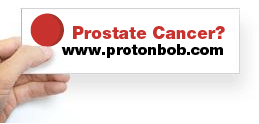 Build awareness about protons with a BOB bumper sticker. Send $6.00 to Bob Hawley: P.O. Box 45, Mt. Angel, OR 97362 and he’ll mail you one. Or, email Bob at [email protected].
Build awareness about protons with a BOB bumper sticker. Send $6.00 to Bob Hawley: P.O. Box 45, Mt. Angel, OR 97362 and he’ll mail you one. Or, email Bob at [email protected].
All proceeds go to the Robert J. Marckini Endowed Chair for proton therapy research at LLUCC.

Last Month’s Brain Teaser
This one was for the mathematicians in our group. It was a tough one, but apparently our members are very intelligent. We received more responses, and more correct responses, to last month’s brain teaser than any other in the history of BOB Tales brain teasers.
A high school math teacher told the class that mathematics is not an exact science and used a set of equations to illustrate his point. The result was that 1 = 2, which can’t be … or can it? Here is the explanation he used.
Let’s say A = 1 and B = 1. The A = B correct? If A = B and you multiply each side of the equation by A, you get A2 = AB. If you then subtract B2 from both sides, you get A2 – B2 = AB – B2. Factoring both sides makes the equation (A + B)(A – B) = B(A - B). Then dividing both sides by (A – B) leaves A + B = B. And knowing that A = B, this means that B + B = B, or 2B = B, or 2 = 1.
Answer: See where you divided both sides by (A – B)? You can’t do that. Why? Because A and B are equal. A minus B equals zero, and you can’t divide by zero. The result is bound to be an error.
Winner: BOB member Wayne Swartz of Uniontown, PA, is last month’s brain teaser winner! Wayne has an interesting story to tell. He and his urologist noticed his PSA rising for years; his urologist treated him for prostatitis and performed two (negative) biopsies before Wayne’s PSA hit 10.5 in early 2002. “Then my urologist suddenly closed up shop and left town,” Wayne said.
Below is an excerpt from Wayne’s testimonial on our website:
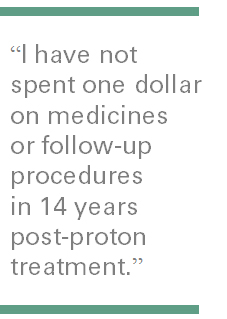 My records sat on my desk for six months while I looked for another urologist. The new urologist did a third biopsy. Laboratory tests showed 7 of 13 samples positive for “technical-termed” carcinomas: Gleason score 6/7, T2A. I wasn’t convinced the test was correct and went for a second and a third opinion. Then I read about Maitake mushroom supplements and took them faithfully for four months. For the first time in years, my PSA fell from 10.5 to 8.5 and back to 9.5.
My records sat on my desk for six months while I looked for another urologist. The new urologist did a third biopsy. Laboratory tests showed 7 of 13 samples positive for “technical-termed” carcinomas: Gleason score 6/7, T2A. I wasn’t convinced the test was correct and went for a second and a third opinion. Then I read about Maitake mushroom supplements and took them faithfully for four months. For the first time in years, my PSA fell from 10.5 to 8.5 and back to 9.5.
I kept delaying all the “recommended” treatments for prostate cancer because they all had frightening side effects.
I thought I had searched the Web so much, but still hadn’t found anything that seemed manageable. What was I looking for?
During the year and a half of delays and “foot-dragging” there were so many “coincidences” that postponed my prostate cancer treatment … I was three days from signing up for seeds when an old friend of the family dropped a note in my mailbox … He had a friend whose father had prostate cancer and had received something called proton therapy at a place called Loma Linda University Cancer Center in California. The note in my mailbox contained a Web address: www.protons.com
So, I am extremely grateful for the “mushroom supplements delay,” the old-urologist-leaving-town delay, the second and third opinions delay, the many appointments with both urologists and radiation oncologists delay; and I’m especially grateful for that note in my mailbox.
My proton treatment was trouble-free—no muss, no fuss, no blood, no meds ... not even an aspirin.
 Fourteen years later, Wayne’s PSA is low and steady. He bales and physically handles about 13,000 bales of hay a year as well as many horses in a three-county area.
Fourteen years later, Wayne’s PSA is low and steady. He bales and physically handles about 13,000 bales of hay a year as well as many horses in a three-county area.
The best part of the proton treatment? Wayne told us, “I have not spent one dollar on medicines or follow-up procedures in 14 years post-proton treatment. As I said, I have friends and colleagues that have had other modes of prostate cancer treatment and they all had follow-up treatments with much expense and physical problems. I’m glad I did my own research on all treatment options, and I’m glad I found proton therapy and Loma Linda University Cancer Center.
Here is a photo of Wayne on one of his collector tractors, a 1977 winning the barrel-roll competition at an antique tractor show.
Since this is a second win for Wayne, he asked that we donate his signed copy of Bob’s book to a local library. Thank you, Wayne!
New Brain Teaser: Observation Quiz
This was sent to us by Ambassador Joseph Verner Reed in 2005.
This can be more difficult than it looks; it just shows how little most of us really see. The average person gets seven correct. There are 20 questions about things we see every day or have known about all our lives. How many can you get right? No getting out of your chair! No using anything on or in your desk or computer! Write down your answers and then check your answers ONLY AFTER completing all the questions. Let’s see how observant you really are!
- On a standard traffic light, is the green on the top or bottom?
- How many states are there in the USA? Don’t laugh! Some people don't know.
- In which hand is the Statue of Liberty’s torch?
- What six colors are on the classic Campbell’s soup label?
- What two numbers on the telephone dial don’t have letters by them?
- When you walk does your left arm swing with your right or left leg?
- On the United States flag, is the top stripe red or white?
- What is the lowest number on the FM dial?
- Which way does water go down the drain, counter or clockwise?
- On which side of a women’s blouse are the buttons?
- Which way do fans rotate?
- How many sides does a stop sign have?
- Do books have even-numbered pages on the right or left side?
- How many sides are there on a standard pencil?
- How many hot dog buns are in a standard package?
- On which playing card is the card maker’s trademark?
- On which side of a Venetian blind is the cord that adjusts the opening between the slats?
- There are 12 buttons on a touch-tone phone. What 2 symbols bear no digits?
- How many curves are there in the standard paper clip?
- Does a carousel turn counter or clockwise?
Answers can be found after the “Quote of the Month.” We will send a signed copy of Bob’s book to the first person who tells us he/she scored 17 or higher! Email Deb at [email protected]. FYI: Bob got 16 correct, and Deb got 13.
The Celebrity and the Nursing Home
On day a famous celebrity went to a nursing home to visit the residents and make them smile. When he got there, everybody greeted him because, of course, everybody recognized him from television. One man, he noticed, didn’t come up to him or say anything to him, so the famous man walked up to the man and asked him, “Do you know who I am?” The old man replied, “No, but you can go to the front desk and they’ll tell you.”
Oops
Little Sally approached her elderly grandfather in the living room, “Grandpa, could you please make a noise like a frog?”
“Why would you want me to do that, sweetheart?” asked Grandpa.
“Because mommy said, ‘When Grandpa croaks we’re all going to Disneyland.’”

Quote of the Month:
“After a certain age, if you don’t wake up aching in every joint, you are probably dead.”
—Unknown

Answers to Quiz:
1) Bottom; 2) 50; 3) Right; 4) Blue, red, white, yellow, black, and gold; 5) 1 and 0; 6) Right; 7) Red; 8) 88; 9) Clockwise (north of the equator); 10) Left; 11) Clockwise as you look at it; 12) 8; 13) Left; 14) 6; 15) 8; 16) Ace of spades; 17) Left; 18) * and #; 19) 3; 20) Counter 8;

Meet God. Bring Potato Chips.
(Author unknown)
A little boy wanted to meet God. He knew it was a long trip to where God lived so he packed his suitcase with a bag of potato chips and a six-pack of root beer and started his journey.
When he had gone about three blocks, he met an old man sitting in the park, just staring at some pigeons. The boy sat down next to him and opened his suitcase. He was about to take a drink from his root beer when he noticed the old man looked hungry, so he offered him some chips. The old man gratefully accepted one and smiled at him.
His smile was so warm that the boy wanted to see it again, so he offered him a root beer. Again, he smiled at him. The boy was delighted! They sat there all afternoon eating and smiling, but they never said a word.
As twilight approached, the boy realized how tired he was and he got up to leave; but before he had gone more than a few steps, he turned around, ran back to the old man, and gave him a hug.
The old man gave him his biggest smile ever.
When the boy opened the door to his own house a short time later, his mother was surprised by the look of joy on his face. She asked him, “What did you do today that made you so happy?”
He replied, “I had lunch with God.” Before his mother could respond, he added, “You know what? He’s got the most beautiful smile I’ve ever seen!”
Meanwhile, the old man, also radiant with joy, returned to his home.
His son was stunned by the look of peace on his face and he asked, “Dad, what did you do today that made you so happy?”
He replied, “I ate potato chips in the park with God.” Before his son could respond, he added, “You know, he’s much younger than I expected.”
Too often we underestimate the power of a touch, a smile, a kind word, a listening ear, an honest compliment, or the smallest act of caring, all of which have the potential to turn a life around. People come into our lives for a reason, a season, or a lifetime!
Have lunch with God. Bring chips.
We would like to wish you all a Happy Thanksgiving, a Merry Christmas, a Happy Hanukkah, and a holiday season filled with peace, joy, and good health. We hope the coming year will be overflowing with all the good things in life.
And, of course … Low PSAs to all!
Bob Marckini and Deb Hickey
To print the BOB Tales newsletter or view the newsletter with a larger font size, click here for the PDF file.
NO MEDICAL ADVICE: Material appearing here represents opinions offered by non-medically-trained laypersons. Comments shown here should NEVER be interpreted as specific medical advice and must be used only as background information when consulting with a qualified medical professional.
